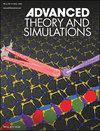Magnetic Semiconductor Nature and In‐Plane Magnetic Anisotropy in WX2 (X = S and Se) Monolayers induced by Doping with FePn Small Clusters (n = 1, 2, and 3)
IF 2.9
4区 工程技术
Q1 MULTIDISCIPLINARY SCIENCES
引用次数: 0
Abstract
Recently, doping with small clusters has been proposed as an efficient method to functionalize 2D materials. Herein, the electronic and magnetic properties of (X = S and Se) monolayers doped with (n = 1, 2, and 3) small clusters are investigated in order to introduce a new approach for the magnetism engineering in 2D transition metal dichalcogenides (2D TMDs). monolayers are nonmagnetic direct‐gap semiconductors. Doping with single Fe atom induces the half‐metallicity with overall magnetic moment of 2.00 and 0.08 in and monolayer, respectively. Herein, Fe impurity and its neighboring S/Se and W atoms produce mainly the magnetic moment. Meanwhile, these 2D materials are metallized by doping with single P atom. In these cases, magnetic moments of 0.71 and 0.60 , respectively, are originated primarily from P atom. The substitution of clusters leads to the emergence of magnetic semiconductor nature in monolayer formed by the semiconductor character in both majority and minority channels. Total magnetic moments of 0.99, 0.00, and 1.00 are obtained by doping with FeP, , and clusters, respectively. These values depend on the magnetic coupling between Fe atom and its neighboring S/Se and W atoms, whereas the contribution from P atom to the system magnetism is negligible. Further, the calculated magnetic anisotropy energy (MAE) indicates in‐plane magnetic anisotropy of the ‐doped and monlayers, where the strength of anisotropy depends on the host monolayer and number of P atoms. The results may introduce new 2D materials for spintronic applications made from monolayers.FePn小簇(n = 1、2和3)掺杂诱导WX2 (X = S和Se)单层的磁性半导体性质和面内磁性各向异性
最近,小簇掺杂被认为是一种有效的二维材料功能化方法。本文研究了(n = 1、2和3)小团簇掺杂(X = S和Se)单层材料的电子和磁性能,为二维过渡金属二硫族化合物(2D TMDs)的磁性工程提供了一种新的方法。单层是一种非磁性直接间隙半导体。单Fe原子掺杂可获得半金属丰度,总磁矩分别为2.00 in和0.08 in。其中,Fe杂质及其相邻的S/Se和W原子主要产生磁矩。同时,这些二维材料通过掺杂单个P原子实现金属化。在这些情况下,磁矩分别为0.71和0.60,主要来自P原子。簇的取代导致磁性半导体性质在单层中出现,这是由多数和少数通道的半导体特性形成的。FeP掺杂得到的总磁矩分别为0.99、0.00和1.00。这些值取决于铁原子与其相邻的S/Se和W原子之间的磁耦合,而P原子对系统磁性的贡献可以忽略不计。此外,计算的磁各向异性能(MAE)表明了掺杂层和单层的平面内磁各向异性,其中各向异性的强度取决于主体单层和P原子的数量。该结果可能为单层自旋电子应用引入新的二维材料。
本文章由计算机程序翻译,如有差异,请以英文原文为准。
求助全文
约1分钟内获得全文
求助全文
来源期刊

Advanced Theory and Simulations
Multidisciplinary-Multidisciplinary
CiteScore
5.50
自引率
3.00%
发文量
221
期刊介绍:
Advanced Theory and Simulations is an interdisciplinary, international, English-language journal that publishes high-quality scientific results focusing on the development and application of theoretical methods, modeling and simulation approaches in all natural science and medicine areas, including:
materials, chemistry, condensed matter physics
engineering, energy
life science, biology, medicine
atmospheric/environmental science, climate science
planetary science, astronomy, cosmology
method development, numerical methods, statistics
 求助内容:
求助内容: 应助结果提醒方式:
应助结果提醒方式:


